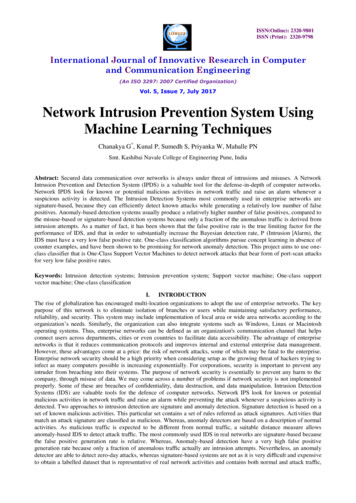
Transcription
ISSN(Online): 2320-9801ISSN (Print): 2320-9798International Journal of Innovative Research in Computerand Communication Engineering(An ISO 3297: 2007 Certified Organization)Vol. 5, Issue 7, July 2017Network Intrusion Prevention System UsingMachine Learning TechniquesChanakya G*, Kunal P, Sumedh S, Priyanka W, Mahalle PNSmt. Kashibai Navale College of Engineering Pune, IndiaAbstract: Secured data communication over networks is always under threat of intrusions and misuses. A NetworkIntrusion Prevention and Detection System (IPDS) is a valuable tool for the defense-in-depth of computer networks.Network IPDS look for known or potential malicious activities in network traffic and raise an alarm whenever asuspicious activity is detected. The Intrusion Detection Systems most commonly used in enterprise networks aresignature-based, because they can efficiently detect known attacks while generating a relatively low number of falsepositives. Anomaly-based detection systems usually produce a relatively higher number of false positives, compared tothe misuse-based or signature-based detection systems because only a fraction of the anomalous traffic is derived fromintrusion attempts. As a matter of fact, it has been shown that the false positive rate is the true limiting factor for theperformance of IDS, and that in order to substantially increase the Bayesian detection rate, P (Intrusion Alarm), theIDS must have a very low false positive rate. One-class classification algorithms pursue concept learning in absence ofcounter examples, and have been shown to be promising for network anomaly detection. This project aims to use oneclass classifier that is One-Class Support Vector Machines to detect network attacks that bear form of port-scan attacksfor very low false positive rates.Keywords: Intrusion detection systems; Intrusion prevention system; Support vector machine; One-class supportvector machine; One-class classificationI. INTRODUCTIONThe rise of globalization has encouraged multi-location organizations to adopt the use of enterprise networks. The keypurpose of this network is to eliminate isolation of branches or users while maintaining satisfactory performance,reliability, and security. This system may include implementation of local area or wide area networks according to theorganization’s needs. Similarly, the organization can also integrate systems such as Windows, Linux or Macintoshoperating systems. Thus, enterprise networks can be defined as an organization's communication channel that helpsconnect users across departments, cities or even countries to facilitate data accessibility. The advantage of enterprisenetworks is that it reduces communication protocols and improves internal and external enterprise data management.However, these advantages come at a price: the risk of network attacks, some of which may be fatal to the enterprise.Enterprise network security should be a high priority when considering setup as the growing threat of hackers trying toinfect as many computers possible is increasing exponentially. For corporations, security is important to prevent anyintruder from breaching into their systems. The purpose of network security is essentially to prevent any harm to thecompany, through misuse of data. We may come across a number of problems if network security is not implementedproperly. Some of these are breaches of confidentiality, data destruction, and data manipulation. Intrusion DetectionSystems (IDS) are valuable tools for the defence of computer networks. Network IPS look for known or potentialmalicious activities in network traffic and raise an alarm while preventing the attack whenever a suspicious activity isdetected. Two approaches to intrusion detection are signature and anomaly detection. Signature detection is based on aset of known malicious activities. This particular set contains a set of rules referred as attack signatures. Activities thatmatch an attack signature are classified as malicious. Whereas, anomaly detectors are based on a description of normalactivities. As malicious traffic is expected to be different from normal traffic, a suitable distance measure allowsanomaly-based IDS to detect attack traffic. The most commonly used IDS in real networks are signature-based becausethe false positive generation rate is relative. Whereas, Anomaly-based detection have a very high false positivegeneration rate because only a fraction of anomalous traffic actually are intrusion attempts. Nevertheless, an anomalydetector are able to detect zero-day attacks, whereas signature-based systems are not as it is very difficult and expensiveto obtain a labelled dataset that is representative of real network activities and contains both normal and attack traffic,
ISSN(Online): 2320-9801ISSN (Print): 2320-9798International Journal of Innovative Research in Computerand Communication Engineering(An ISO 3297: 2007 Certified Organization)Vol. 5, Issue 7, July 2017unsupervised learning approaches for network anomaly detection have been recently proposed. These methods aim towork on datasets of traffic extracted from real networks without the necessity of a labelling process. In Unlabelledanomaly detection systems, we assume that the likeliness of detecting attack patterns in the extracted traffic traces isusually much lower than the likeliness of normal pattern detection. Furthermore, we can use signature-based IDS inorder to filter the extracted traffic by removing the known attacks, thus further reducing the number of attack patternspossibly present in the dataset. One-class classification algorithms pursue concept learning in absence of counterexamples and have been shown to be promising for network anomaly detection. Through this project, our aim is to useone-class classifiers to detect zero-day attacks with respect to probing attacks and prevent them using an IntrusionPrevention System with minimum false positives and true negatives along with minimum latency.II. LITERATURE SURVEYThere was a need to evaluate ways in which you can reduce the number of false positives and false negatives detectedby the IPDS, for this purpose a detailed literature survey was done which included going through various research andsurvey papers on IPDS. Thus, we came across various papers which provided a part of the solution. Ying-Dar L, et al.Tai have explained the concept of credibility based weighted voting In this paper [1] they have employed multiple IDSand applied a method called CWV to the outcomes of multiple IDS for reducing FPs and FNs. First the CWV schemeevaluates the creditability of each individual IDS. For each IDS the scheme then assigns different weights to eachintrusion type according to its FP and FN ratios. Later the outcomes of each IDS are merged using a weighted votingscheme. According to S Wu and E Yen data mining can be used for intrusion detection [2] they have considered fourattack type: U2R, Probe, DOS, R2L and compared their accuracy, the detection rate and false alarm rate [3]. They usedC4.5 and SVM algorithms to provide an accurate comparison of above four kinds of attacks. C4.5 acts better for probe,U2R and DOS attack, but SVM proved better in detecting false alarms, similarly [4]. Anuar NB, et al. has used a hybriddata mining technique along with decision trees. The writers have used training data set of KDD Cup99 and proposed amethod for detecting and statistical analysis of both attack and normal traffics. A hybrid statistical technique based ondata mining and decision tree classification has been used. These methods differentiate between false positives andattacks and thus reduce the misclassification. They prove the importance of decision trees for designing intrusiondetection for class of DOS, normal and R2L by comparing decision tree algorithms and rule-based algorithms [5].“False Positives Reduction via Intrusion Alert Quality Framework”, written by Bakar NA, et al. In this paper thewriters actualize an interruption ready quality system, to decrease false positive cautions in IDS, they advance everyalarm with quality parameters, for example, rightness, precision, dependability, and affectability. Using theseparameters helps in deciding the quality of the alert and whether it really is anything abnormal or just a false alarm. AlMamory SO and H Zhang in [6] “A Survey on IDS Alerts Processing Techniques” has provided a brief understandingof alert processing techniques [7]. It is a survey paper on the various alert processing techniques, they have described adata mining alert clustering strategy that gathers alerts whose primary causes can be compared and discover generalizedalerts which assist the administrator or analyst to write filters [8]. Benjamin M, et al. in the paper “M2D2: A FormalData Model for IDS Alert Correlation” have explained alert processing in a different way, Benjamin Morin proposedcorrelation of Information related to the characteristics of the monitored information system, information about thevulnerabilities, information about the security tools used for the monitoring the events [9]. In the paper “An IntelligentIntrusion Detection and Response System Using Network Quarantine Channels: Adaptive Policies and Alert Filters”Emmanuel Hooper has proposed a model to reduce false positives using adaptive responses of firewall rule sets on“network quarantine channels (NQC) using firewall architectures. The model is a combination of firewall architectureassociated with response rules, to deny access to critical segments to suspicious hosts in the network. Author KaiHwang, et al. “Hybrid Intrusion Detection with Weighted Signature Generation over Anomalous Internet Episodes” hasproposed [10] a hybrid model of signature based IDS and Anomaly Detection System to get low false-positive and tosense unfamiliar attacks [11]. The ADS was trained by exposing to abnormal traffic incidents from Internet connection,which detected anomalies more than the original two independent models, which reduced the total false positives andnegatives generated. Byoungkoo K, et al. has proposed a method for high performance intrusion detection [12]. In thispaper the authors propose the FPAG-based intrusion detection technique to detect and respond variant attacks on highspeed links. It is possible through novel pattern matching mechanism and heuristic analysis mechanism that isprocessed on FPGA-based reconfiguring hardware. The technique is a part of a proposed system, called ATPS(Adaptive Threat Prevention System) recently developed. That is, the proposed system has hardware architecture thatcan be capable of provide the high-performance detection mechanism [13]. Jose G, et al. have used techniques called
ISSN(Online): 2320-9801ISSN (Print): 2320-9798International Journal of Innovative Research in Computerand Communication Engineering(An ISO 3297: 2007 Certified Organization)Vol. 5, Issue 7, July 2017shunting. Shunting is a technique which provides significant benefits for network intrusion prevention in environmentsfor which an IPS can dynamically designate portions of traffic stream as not requiring further analysis. Author YaronW, et al. in their paper [14] has used a pattern-matching algorithm. The algorithm uses the concept of Ternary ContentAddressable Memory and is capable enough of matching multiple patterns in a single operation. This algorithm is ableto detect abnormalities much faster than most of the current detection methods, while attaining similar accuracy ofdetection.2.1 Review of FRR and FARFrom all the studies it is concluded that while some papers proposed different approaches the majority have reduced thefalse positive in the same way. Correlating alerts improve the efficiency of the IDS. It not only decreases the falsepositive rate, but also improves the knowledge of attacks on the network. Despite the reduction of false positive, themethods still need to be improved as they still have weak spots [15].In case for false negatives, anomaly detection does tend to produce more false negatives than in signature baseddetection. Therefore reduction of false negatives depends on the machine learning technique that you use and on howprecise your training data is. From this literature survey we can conclude that, practically, it is not possible to build acompletely secure system and false positive or false negative generation will continue. It is only possible to reduce thenumber of false positives or false negatives [16].2.2 Review of LatencyTo decrease latency is the same as increasing its throughput or performance. To implement a high-performanceIntrusion Prevention and Detection System we need special hardware like high computing GPUs and CPUs, thusmaking it very costly [17]. Not many methods have been developed which reduce this cost to make it feasible todevelop a high performance IPDS. Also, all methods are hardware based, there are extremely few cases where softwarebased techniques are used in increasing performance of an IPDS.III.ANOMALY BASED DETECTIONAnomaly based detection techniques scan through the entire network traffic and classify it as normal or anomalous. Forclassification you need to develop a training set, the system will refer this training set and classify the data as normal oranomalous, therefore the efficiency of your detection system depends on how well you develop your training set. Thetraining set will define what normal traffic is and if the system comes across anything that is not in accordance with thetraining set it will be classified as anomalous. Because of this anomaly based detection techniques also have a highfalse positive generation rate. One major advantage of anomaly based detection techniques over signature based is thedetection of zero day attacks since novel attacks are detected as soon as they take place [18]. There are various anomalybased detection techniques that are used like-Statistical Models, Cognition Models, Cognition Based DetectionTechniques, Machine learning based detection techniques. In this paper we will be focusing on Support VectorMachine (SVM) which is a machine learning based detection technique. We will be inspecting network packets forprobing attacks.IV.PROPOSED SYSTEM ARCHITECTUREFrom all the papers we referred to during our research phase, we came across different ways to implement IPS and IDS,but we did not come across a system where both IPS and IDS were implemented together as a cohesive unit. In ourproposed architecture, IPS is in-line with the network and the IDS will sniff all the packets and will maintain a log toenter all entries of packets that go through from the internet into the internal network. Here, IPS and IDS will havedifferent functionalities [19]. The payload of the packets coming in will be inspected by the IPS for any malicious code,and will either block the packet or accept it and allow it to flow into the internal network. If it comes across a packetwhich is unknown to the IPS it will block (Figure 1). The blocked packets will then be inspected by the IDS to look formore intricate details. We will be using one-class SVM as a machine learning technique to classify the packets asmalicious or normal [20]. If the payload seems normal to the IDS then it will be allowed to flow back into the internalnetwork along with the other packets. But if any irregularity is detected, the packet will immediately be discarded.After these operations have been performed by the IDS it will update its rule base and subsequently will send theseupdated rules to the IPS so that the IPS will know what to do if it comes across a packet of similar type. This processwill be repeated whenever the IPS comes across an unknown packet [21].
ISSN(Online): 2320-9801ISSN (Print): 2320-9798International Journal of Innovative Research in Computerand Communication Engineering(An ISO 3297: 2007 Certified Organization)Vol. 5, Issue 7, July 2017Figure 1: System architecture.V. LEARNING SCHEMESFor various applications, which involve machine learning different learning schemes are implemented. For intrusiondetection, two learning schemes are prevalent: classification and anomaly detection (Figure 2). Classification is theproblem of identifying the class a new data object belongs to when given a training set of data containing observationswhose category membership is known [22]. In other words, in classification, we have observations from two classes ofdata and the machine trains according to these observations. When a new observation is given as an input, the machinewill classify the new observation as one of the two classes it has learned about. For this, the prerequisite is having twoclasses of data for training purposes [23]. Many a times, it is not possible to obtain sufficient amount of data for boththe classes, and hence this method should be avoided if possible. For the reason given above, we adopt the anomalydetection learning scheme (Figure 3). Anomaly detection is the identification of the observations that do not follow acertain expected pattern (outliers) in a dataset. Here, only one class of datasets is required to train the machine. Thefocus here is on only one prominent class and on learning its structure. As a result, it is possible to differentiate thatclass from everything else (outliers). By using this approach, it is possible to detect unknown attacks [24].Figure 2: Classification.Figure 3: Anomaly detection.VI. SUPPORT VECTOR MACHINEWe will briefly discuss about SVM before moving on to one-class classification and one-class SVMs. Support VectorMachines (SVM) is a discriminative classifier formally defined by a separating hyperplane [25]. In this machinelearning technique, we basically find a hyperplane that can separate the data into two classes. This hyperplane shouldbe able to linearly separate the patterns. Also, it can be extended to patterns that are not linearly separable bytransforming data into new space. A basic working of SVM is shown in Figure 4.
ISSN(Online): 2320-9801ISSN (Print): 2320-9798International Journal of Innovative Research in Computerand Communication Engineering(An ISO 3297: 2007 Certified Organization)Vol. 5, Issue 7, July 2017Figure 4: Basic working of SVM.Some unique features of support vector machine are: These algorithms give theoretical guarantees about their performance. Have a modular design that allows one to separately implement and design their components. Not affected by local minima. Do not suffer from curse of dimensionality. They can be used for both: regression and classification tasks.VII. ONE-CLASS CLASSIFICATIONThese techniques are generally useful when there are “two-class learning” problems referred to as “target” class and“outlier” class. The target class is well-sampled whereas; the outlier class is under-sampled [26-28]. The goal of oneclass classification is to distinguish between target objects and outliers by constructing a decision surface around all thetarget points. The end result of this would be all the normal packets (target data) will be surrounded by a hyperplane.Any incoming packet with a payload which is of different pattern will fall outside this boundary. Thus, we can train themachine with all kinds of normal traffic and any unknown attacks will automatically be filtered out. Usually there is a“rejection rule” that is taken into consideration during the training. The rejection rate makes sure that a certainpercentage of training pattern lies outside the constructed decision surface. This will in turn help us to obtain a moreprecise description of the target class since it considers the presence of noise (unlabeled outliers) while training. Incases where the training datasets contains only pure target patterns, this rejection rate can be thought of as tolerablefalse positive rate [29,30].VIII. ONE-CLASS SVMTraditionally SVM is used for two-class classification. As described earlier, given a dataset that is not linearlyseparable, the SVM can separate such data using hyperplanes and kernel functions. This means that the data points thatcannot be separated by a straight line in the original space I are lifted to a feature space F, where there can be a straighthyperplane that separated the data points accordingly. On projecting this hyperplane back to the original space I, thishyperplane would take the form of non-linear curve [31].Coming to one-class SVM, this technique is a modified version of SVM, wherein only one class of data is required forclassification. We will be using the one-class SVM approach that was proposed by Scholkopf et al. [32]. They mappedthe data into the feature space corresponding to the kernel and to separate them from the origin with maximum margin[24]. So basically, this method separates all the data points in feature space F from the origin and maximizes thedistance of this hyperplane to the origin for obtaining better margins. The result is a binary function, which returns 1for all the data points lying in a “small region” (which represents the target data) and -1 elsewhere. To separate the dataset from the origin, the following quadratic minimization function is used:min F , R , R112 2v ii
ISSN(Online): 2320-9801ISSN (Print): 2320-9798International Journal of Innovative Research in Computerand Communication Engineering(An ISO 3297: 2007 Certified Organization)Vol. 5, Issue 7, July 2017Subject to( . ( xi )) i , i 0Here, the slack variables ξi are introduced to allow some data points to lie inside the margin in order to avoid overfitting. The ν determines the trade-off between maximizing the margin and the number of points lying in that margin.Thus, it sets an upper bound on the fraction of outliers and also a lower bound on the training examples used.Solving the above equation gives us the following decision function:nf ( x) sgn(( . ( xi ) ) sgn( i K ( x, xi ) )i 1From this function, it is evident that any data x, whose value is positive, lies in the training set, or in the target region.A popular choice for kernel function is the Gaussian kernel, which is given by:K ( x, x ') exp( x x'2 22)Where, σ R is a kernel parameter and // x-x’ // is the dissimilarity measure.IX. PROJECT IMPLEMENTATIONThe implementation of this project has been initiated by dividing the architecture into two halves. The first halfcontains the intrusion detection system which is placed in-line to the network. The main function of this intrusiondetection system is to analyze the packets traveling through the network and check them against rules to flag unsafepackets or intrusion attempts. An attempt to an intrusion or any packet flagged by the rule-set will be stored in adatabase as a report. The second half of the system is the intrusion prevention system. The function of this system is tolook for unknown attacks or zero-day attacks. To do so, this system extracts suspicious packets using a sniffing tool.This packet data is then normalized for the machine learning algorithm. The normalized data is then compared to atrained model which separates the unsafe packets. For the purpose of this classification, we use a one-class classifierthat is, One-Class Support Vector Machine (OCSVM). We train the OCSVM w.r.t the safe packets.Thus, any packet that is not having similar features will get flagged as unsafe packet. Once a packet is flagged in themachine learning algorithm as unsafe, the packet details are then used by a program which updates the rules of thedetection system to block the attack appropriately. It allows a node with over used battery to refuse to route the trafficin order to prolong the network life. In [6] Authors had modified the route table of AODV adding power factor field.Only active nodes can take part in rout selection and remaining nodes can be idle.9.1 Tools Useda) Snort:Developed by Source fire, Snort is a free and open source network intrusion prevention system (NIPS) andnetwork intrusion detection system (NIDS), which was created by Martin Roesch [33]. For the implementationof this system, Snort is configured as an Intrusion Prevention System. Snort uses a rule base to filter packets,hence once a packet has been identified as malicious by the machine learning algorithm, the rule base isupdated via a C script and Snort can prevent those packets in the future.b) Barnyard2 and MySQL:Barnyard2 is an open source interpreter for Snort unified2 binary output files. Its primary use is allowing Snortto write to disk in an efficient manner and leaving the task of parsing binary data into various formats to aseparate process that will not cause Snort to miss network traffic. Barnyard supports MySQL. All the reportsgenerated by Barnyard are stored in MySQL database. This module is used for generating alerts and reportsfor the network administrator.
ISSN(Online): 2320-9801ISSN (Print): 2320-9798International Journal of Innovative Research in Computerand Communication Engineering(An ISO 3297: 2007 Certified Organization)Vol. 5, Issue 7, July 2017c)Wireshark:Wireshark is a free and open source packet analyser. It is used for network troubleshooting, analysis, softwareand communications protocol development, and education [34]. This system uses Wireshark as a packetsniffer. A PCAP file is generated from Wireshark which contains all the sniffed packets. This file is furthersent to the KDD Extractor which further extracts all the features from packets with respect to the KDD Datasetfeatures. The extractor generates a CSV file which is sent to R.d) R:R is a programming language and software environment for statistical computing and graphics supported bythe R Foundation for Statistical Computing. It is extensively used by data miners for developing statisticalsoftware and data analysis. It is an important tool for computational statistics, visualization and data science.Moreover, R is easily extensible through functions and extensions, and the R community is noted for its activecontributions in terms of packages. The system uses R for classifying between safe and unsafe packets. Themachine learning algorithm, One-Class Support Vector Machine has been implemented through R with thehelp of the package: e1071. This package provides the usage of OCSVM with various kernels such as Linear,Gaussian, Polynomial and so all. We chose the Gaussian Kernel, as empirical results have shown it to be thebest kernel for implementing the OCSVM. The packets are then classified and the unsafe packets are flaggedand sent to the C Script for rule updating.e)GCC:The GNU Compiler Collection (GCC) is a compiler system produced by the GNU Project supporting variousprogramming languages. GCC is a key component of the GNU tool chain and the standard compiler for mostUnix-like Operating Systems. The Free Software Foundation distributes GCC under the GNU Public License[35]. A C script was written to update the rules of Snort per the false packets detected by OCSVM.f)KDD extractor:The KDD Extractor is a module that takes live traffic packets or a PCAP file as input and extracts KDDfeatures from all packets. The output is stored in a CSV file.9.2 TrainingFor training the machine learning model two datasets were used. Since we are using a One-Class classificationalgorithm, we trained our model only for the normal or ‘safe’ packets. Initially we used our home network forgenerating a database, but due to limitations in the variety of traffic being generated we chose to use the NSL-KDDdataset along with our self-generated dataset. Another reason for using the NSK-KDD dataset was that, the systemis focused on detecting and preventing probing attacks only. So, this dataset was the appropriate choice because itthe data focuses on Probing Attacks such as Denial of Service (DoS) attacks, User to Root (U2R) attacks andRemote to Local (R2L) attacks. Hence, we obtained labeled data focusing on probing attacks which we used fortesting purposes.9.3 NSL-KDD DatasetThe NSL KDD Dataset is a subset of the original KDD Dataset which solves some of the inherent problemspresent in the original dataset. The NSL KDD Dataset does not include the redundant data present in the originaldataset, thus the classifiers are not inclined towards frequently occurring entries while learning. Another bigadvantage is that the number of testing and training data is reasonable as compared to the original dataset. Thisfactor makes it execution of the learning algorithms very smooth and affordable [32].X.RESULTS10.1 ScalabilityThe scalability of the system was derived using the size of the dataset and latency of the dataset as parameters.As seen in the graph (number), the size of the dataset is growing exponentially with marginal increase inlatency.
ISSN(Online): 2320-9801ISSN (Print): 2320-9798International Journal of Innovative Research in Computerand Communication Engineering(An ISO 3297: 2007 Certified Organization)Vol. 5, Issue 7, July 2017Figure 5: Scalability graph.From the graph given in Figure 5, an exponential relation can be deduced given as:size of dataset α latencyThus, equation can be given as:y kaxWhere:y is the size of datasetx is the latency in milli-secondsk and a are non-zero constants which are calculated to be:k 0.01384a 9.33Thus,y 0.01384 101.3x10.2 LatencyThe time required for a packet to be filtered, analyzed by the machine learning algorithm and make a ruleupdate, if any, was calculated as latency. The datasets considered contained all unsafe packets and thus theresults below are worst-case times (Table 64.23.95.94.45.5Table 1: Latency observations.As recorded, the latency increases marginally even when the size of the dataset increases more than 8 times theoriginal. This is shown in the graph given in Figure 6.Figure 6: Latency trend.
ISSN(Online): 2320-9801ISSN (Print): 2320-9798International Journal of Innovative Research in Computerand Communication Engineering(An ISO 3297: 2007 Certified Organization)Vol.
Intrusion Prevention and Detection System (IPDS) is a valuable tool for the defense-in-depth of computer networks. Network IPDS look for known or potential malicious activities in network traffic and raise an alarm whenever a suspicious activity is detected. The Intrusion Detection Systems most commonly used in enterprise networks are











